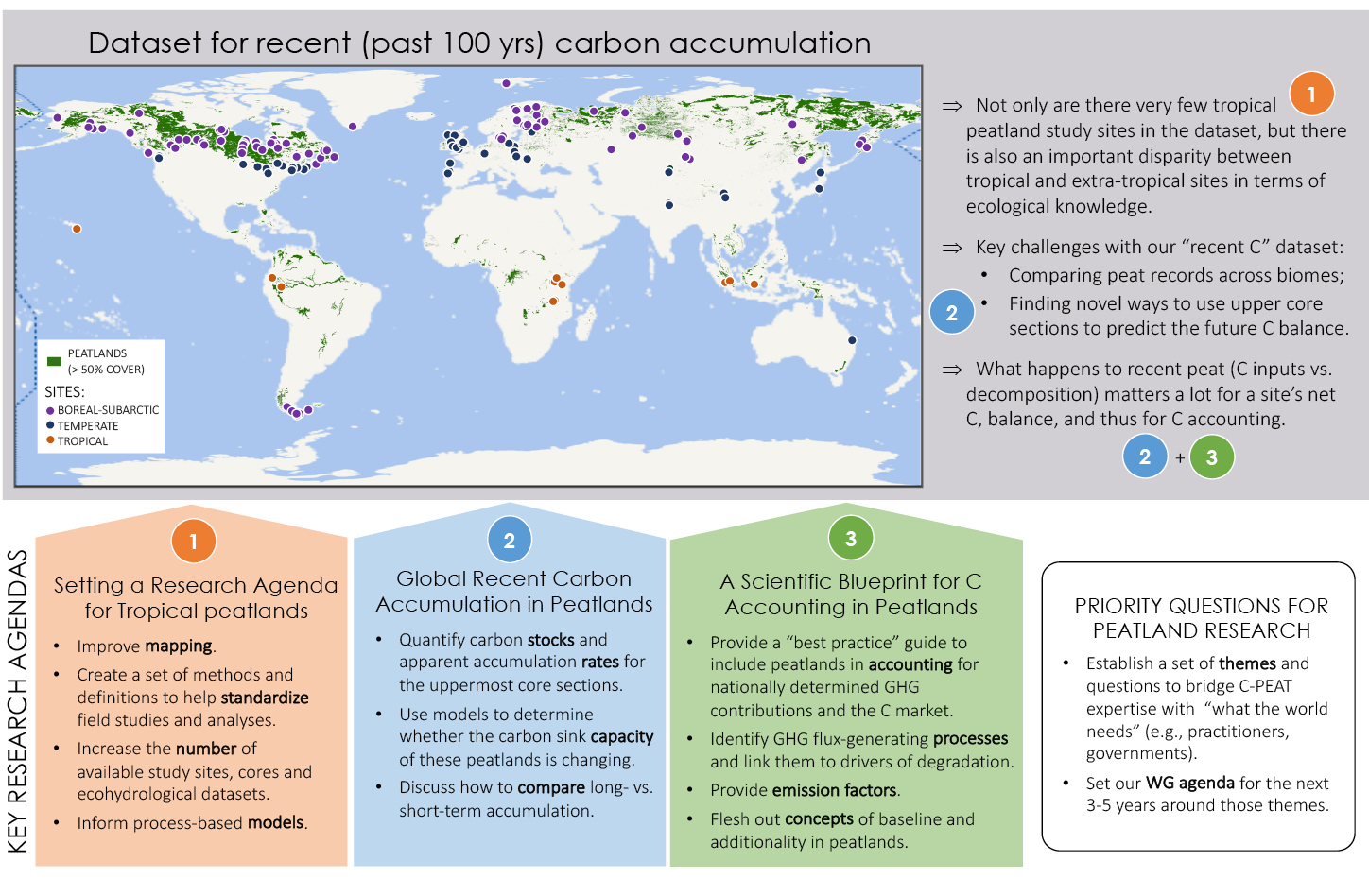- Home
- Publications
- PAGES Magazine
- Setting a New Research Agenda For Tropical Peatlands, Recent Carbon Accumulation and Ecosystem Services
Setting a new research agenda for tropical peatlands, recent carbon accumulation and ecosystem services
Nicole K. Sanderson, J. Loisel, A. Gallego-Sala, G. Anshari, N. Novita, K. Marcisz, M. Lamentowicz, M. Bąk and D. Wochal
Past Global Changes Magazine
31(2)
121
2023
Nicole K. Sanderson 1,
1,
J. Loisel 2,
2,
A. Gallego-Sala 3,
3,
G. Anshari4,
N. Novita5,
K. Marcisz6,
M. Lamentowicz6,
M. Bąk6 and
D. Wochal6
J. Loisel
A. Gallego-Sala
G. Anshari4,
N. Novita5,
K. Marcisz6,
M. Lamentowicz6,
M. Bąk6 and
D. Wochal6
C-PEAT workshop, Pontiana, Indonesia, Poznań, Poland, Truckee, USA, and online, 8–12 May 2023
Carbon in peatlands through time
Peatlands play an important role in the global carbon cycle, namely as a large carbon store and a major source of methane emissions into the atmosphere. Across the globe, climate, peat fires, and land-use changes are impacting the peatland carbon balance and, in many cases, turning peatlands into net carbon sources. Peatlands are also unique ecosystems acting as global environmental archives – some tropical peats are dated back as far as 40,000 years old!
While conservation and restoration activities have gained in popularity and can slow down peat-carbon losses, a predictive understanding of peatlands’ complex responses to current and projected changes is critically needed, particularly for tropical peatland functioning and recent peatland dynamics (especially in the last ~100 years).
Our current (and incomplete) understanding hampers the pressing need to transfer knowledge on peat-carbon cycling to managers, practitioners, policymakers, as well as to communities; it also limits our capacity to integrate peatlands into Earth System Models that forecast feedbacks to the global carbon cycle and climate system.
The main goal of the Carbon in Peat on EArth through Time (C-PEAT) working group (WG) (pastglobalchanges.org/c-peat) is to understand peatland dynamics over different timescales, from the past millennia into modern times, and make predictions about their future behavior in the face of global, as well as local, changes. To do so, we use peat-core records to reconstruct past ecohydrological and paleoclimate changes, and link said past conditions with changes in peatland dynamics. These paleo datasets are combined with modern-day measurements (e.g. gas-flux data) and models. Our group members are also working on nature-based climate solutions, including peatland restoration and conservation.
A truly global (and low carbon) meeting
This year’s C-PEAT workshop (pastglobalchanges.org/calendar/136966) was held simultaneously in three international hubs (Indonesia, Poland and USA). While each hub had its own schedule of speakers and activities, all three hubs shared a similar research agenda (for the meeting guide and links to talks, see: shorturl.at/hjxJW). We also held daily two hour-long “global discussions” where all three hubs met online and shared the prior day’s key messages and ideas.
A total of 48 in-person and 16 online participants gave talks, and an additional 30 online participants took part in the workshop. Day 1 focused on setting a research agenda for tropical peatlands; days 2 and 3 were dedicated to issues and potential solutions to quantifying recent peatland carbon dynamics, and day 4 was devoted to sharing recent progress on our current data community products and looking back at the work that had been done during the second phase of our WG.
 |
|
Figure 1: Key research agendas and priority questions for the future of peatland research and the C-PEAT working group. |
We also outlined our research priorities for the next phase of C-PEAT (Fig. 1) while discussing ways to keep our core identity as paleo-peat scientists. Indeed, our community of practice has rapidly broadened over the past few years and now includes modelers and modern-measurement scientists, restoration and conservation scientists, as well as stakeholders specializing in carbon accounting. On day 5, some hubs organized field trips for the local participants. Lastly, the workshop has greatly broadened our core of scientists, particularly early-career and from low-and-middle income countries.
ACKNOWLEDGEMENTS
Thanks to the following organizations for funding support: Future Earth’s Past Global Changes (PAGES), The International Union for Quaternary Research (INQUA), UNESCO’s International Geoscience Programme (IGCP), The US National Science Foundation (NSF), Yayasan Konservasi Alam Nusantara/The Nature Conservancy Indonesia Business Unit, and Adam Mickiewicz University, Poznań, Poland.
affiliationS
1Département de géographie, Université du Québec à Montréal, Canada
2Department of Geography, Texas A&M University, College Station, USA
3Department of Geography, University of Exeter, UK
4Universitas Tanjungpura, Pontianak, Indonesia
5Yayasan Konservasi Alam Nusantara, Jakarta, Indonesia
6Climate Change Ecology Research Unit, Adam Mickiewicz University, Poznań, Poland
contact
Julie Loisel: julieloisel tamu.edu
tamu.edu
